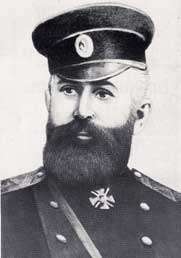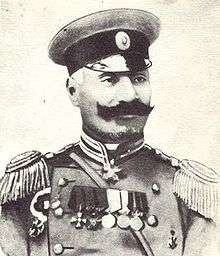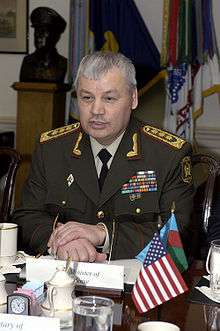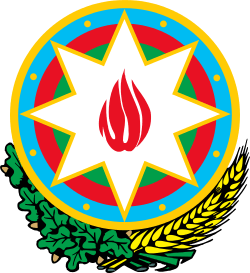Military history of Azerbaijan
Part of a series on the |
|---|
| History of Azerbaijan |
 |
|
Early modern history |
|
|
The Azerbaijanis are believed to be inheritors of various ancient civilizations and peoples including the indigenous Caucasian Albanians, Iranian tribes such as Scythians and Alans, and Oghuz Turks among others (note that several modern peoples of the Caucasus can trace their ancestries to more than one of these same ancient peoples).
The country location in the crossroads of Europe and Asia and made it possible for Azeris to have military contact both with European and Oriental forces.
Ancient history
Caucasian Albania

Caucasian Albanians are believed to be the earliest inhabitants of Azerbaijan.[1] Early invaders included the Scythians in the 9th century BCE.[2] The South Caucasus was eventually conquered by the Achaemenids around 550 BCE. During this period, Zoroastrianism spread in Azerbaijan. The Achaemenids in turn were defeated by Alexander the Great in 330 BCE. Following the decline of the Seleucids in Persia in 247 BCE, an Armenian Kingdom exercised control over parts of modern Azerbaijan between 190 BCE to 428 CE.[3][4] Caucasian Albanians established a kingdom in the 1st century BCE and largely remained independent until the Sassanids made the kingdom a province in 252 CE.[1][5][6] Caucasian Albania's ruler, King Urnayr, officially adopted Christianity as the state religion in the 4th century CE, and Albania would remain a Christian state until the 8th century.[7][8] Sassanid control ended with their defeat by Muslim Arabs in 642 CE.[9]
Islamic Conquests
Muslim Arabs defeated the Sassanids and Byzantines as they marched into the Caucasus region. The Arabs made Caucasian Albania a vassal state after the Christian resistance, led by Prince Javanshir, surrendered in 667.[1] Between the 9th and 10th centuries, Arab authors began to refer to the region between the Kura and Aras rivers as Arran.[1] During this time, Arabs from Basra and Kufa came to Azerbaijan and seized lands that the indigenous peoples had abandoned; the Arabs became a land-owning elite.[10] Despite pockets of continued resistance, the majority of the inhabitants of Azerbaijan converted to Islam. Later on in the 10th and 11th centuries, Kurdish dynasties of Shaddadid and Rawadid ruled parts of Azerbaijan.
Middle Ages
Seljuqs and successor states
The Seljuq period of Azerbaijan's history was possibly even more pivotal than the Arab conquest as it helped shape the ethno-linguistic nationality of the modern Azerbaijani Turks.
After decline of Abbasid Khalifate, the territory of Azerbaijan was under the sway of numerous dynasties such as the Salarids, Sajids, Shaddadids, Rawadids and Buyids. However at the beginning of the 11th century, the territory was gradually seized by waves of Oghuz Turkic tribes emanating from Central Asia. The first of these Turkic dynasties was the Ghaznavids from northern Afghanistan, who took over part of Azerbaijan by 1030. They were followed by the Seljuqs, a western branch of the Oghuz who conquered all of Iran and the Caucasus and pressed on to Iraq where they overthrew the Buyids in Baghdad in 1055.
The Shirvanshahs
Shīrwān Shāh[11] or Sharwān Shāh,[11] was the title in mediaeval Islamic times of a Persianized dynasty[11] of Arabic origin.[11] The Shirvanshah established a native Azeri state[12] and were rulers of Shirvan, a historical region in present-day Azerbaijan. The Shirvanshahs established the longest Islamic dynasty in the Islamic world.
Safavids and the rise of Shi'a Islam

The Safavid (Safaviyeh) were a Sufi religious order formed in 1330s by Sheikh Safi Al-Din (1252–1334), after whom it was eponymously named.
This Sufi order openly converted to the heterodox branch of twelver Shi'a Islam by the end of the 15th century. Some Safavid followers, most notably the Qizilbash Turks, believed in the mystical and esoteric nature of their rulers and their relationship to the house of Ali, and thus, were zealously predisposed to fight for them. The Safavid rulers claimed to be descended from Ali himself and his wife Fatimah, daughter of the Prophet Muhammad, through the seventh Imam Musa al-Kazim. Qizilbash numbers increased by the 16th century and their generals were able to wage a successful war against the Ak Koyunlu state and capture Tabriz.
The Safavids, led by Ismail I, expanded their base, sacking Baku in 1501 and persecuting the Shirvanshahs.
Russian Rule
Following their defeat by Russia, Qajar Persia was forced to sign the Treaty of Gulistan in 1813, which acknowledged the loss of the territory to Russia. Local khanates were either abolished (like in Baku or Ganja) or accepted Russian patronage. Another Russo-Persian war in 1826-28 resulted in another crushing defeat for the Iranian army. The Russians dictated another final settlement as per the Treaty of Turkmenchay, which resulted in the Qajars of Persia ceding Caucasian territories in 1828. The treaty established the current borders of Azerbaijan and Iran as the rule of local khans ended. In the Russian-controlled territories, two provinces were established that later constituted the bulk of the modern Republic - Elisavetpol (Ganja) province in the west, and Shamakha province in the east.
After 20th century

At the collapse of the Russian Empire in 1917, an independent republic was proclaimed in Ganja on May 28, 1918 following an abortive attempt to establish a federal Transcaucasian Republic with Armenia and Georgia.This was the first Democratic Republic established in Islamic World.
Among the important accomplishments of the Parliament was the extension of suffrage to women, making Azerbaijan the first Muslim state in the world to give women equal political rights with men. In this accomplishment, Azerbaijan preceded even such developed countries as the United Kingdom and the United States. Another important accomplishment of ADR was the establishment of Baku State University, which was the first modern-type university founded in Azerbaijan.
Azerbaijan Democratic Republic


The history of the modern Azerbaijan army dates back to Azerbaijan Democratic Republic in 1918, when the Armed Forces of Azerbaijan Republic were created on June 26, 1918. First de facto Minister of Defense of ADR was Dr. Khosrov bey Sultanov. When the Ministry was formally established, Gen. Samedbey Mehmandarov became the minister, and Lt-Gen. Ali-Agha Shikhlinski his deputy. Chiefs of Staff of ADR Army were Maj-Gen. Habib Bey Salimov (August 1, 1918 - March 26, 1919), Lt-Gen. Mammad Bey Shulkevich (March 26, 1919 - December 10, 1919) and Maj-Gen. Abdulhamid Bey Gaytabashi (December 10, 1919 – April 28, 1920).[13][14]
The Red Army invaded Azerbaijan on April 28, 1920. Although the bulk of the newly formed Azerbaijani army was engaged in putting down an Armenian revolt that had just broken out in Karabakh, the Azeris did not surrender their brief independence of 1918-20 quickly or easily. As many as 20,000 of the total 30,000 soldiers died resisting what was effectively a Russian reconquest.[15] The national Army of Azerbaijan was abolished by the Bolshevik government, 15 of the 21 army generals were executed by the Bolsheviks.[13]
Some of Azerbaijan Democratic Republics most prestigious generals were:
- Lieutenant-General Samad bey Mehmandarov (1855–1931)
- Lieutenant-General, Ali-Agha Shikhlinski (1865–1943)
- General-Adjutant, Huseyn Khan Nakhchivanski (1863–1919)
- Major-General, Abdulhamid Bey Gaytabashi (1884–1920)
- Major-General, Habib Bey Salimov (1881–1920)
- Major-General, Ibrahim bey Usubov (1875–1920)
- Major-General, Murad Girey Tlekhas (1874–1920)
- Major-General, Emir-Kazim Mirza Qajar (1853–1920)
- Major-General, Mammad Mirza Qajar (1872–1920)
- Major-General, Aliyar-Bek Gashimbekow (1856–1920)
- Major-General, David-Bek Edigarow (1881–1920)
- Major-General, Firidun-Bey Wezirow (1850–1925)
- Major-General, Khalil-Bey Talishkhanov (1859–1920)
 Parade of the army of Azerbaijan Democratic Republic.
Parade of the army of Azerbaijan Democratic Republic. Officers of the army of ADR
Officers of the army of ADR Soldiers of the army of ADR.
Soldiers of the army of ADR. Orchestra of the army of Azerbaijan Democratic Republic.
Orchestra of the army of Azerbaijan Democratic Republic.
Navy
The Azerbaijani Navy was established in 1918. When the Russian Empire collapsed, ADR inherited the entire Russian Caspian flotilla. Among the vessels of the ADR was the gunboats Kars, Ardahan, Astrabad, Geok-Tepe, Arax and Bailov. The British also handed over its warship, in the Caspian Sea - a former Russian vessel, to the newly independent Azerbaijan.[16]
World War II
During World War II, Azerbaijan played a crucial role in the strategic energy policy of Soviet Union, much of the Soviet Union's oil on the Eastern Front was supplied by Baku. By the Decree of the Supreme Soviet of the USSR in February 1942, the commitment of more than 500 workers and employees of the oil industry of Azerbaijan was awarded orders and medals. Operation Edelweiss carried out by the German Wehrmacht targeted Baku because of its importance as the energy (petroleum) dynamo of the USSR.[17] Some 800,000 Azerbaijanis fought well in the ranks of the Soviet Army of which 400,000 died and Azeri Major-General Azi Aslanov was awarded twice Hero of the Soviet Union.
Karabakh War
In summer 1992, the Defense Ministry of Azerbaijan, following a resolution by the Azerbaijani president on the privatization of units and formations in Azerbaijani territory, forwarded an ultimatum demanding control over vehicles and armaments of the 135th and 139th motorized rifle regiments of the 295th Motor Rifle Division.[18] Azerbaijan had been the deployment area of units of the 4th Army that consisted of four motorized rifle divisions (23rd, 60th, 296th and 75th) and prescribed army units that included missile and air defense brigades and artillery and rocket regiments. It also hosted the 49th arsenal of the Main Agency of Missiles and Artillery of the Ministry of Defense of the Russian Federation, which contained over 7,000 train-car loads of ammunition to the excess of one billion units. The transfer of the property of the 4th Army (except for part of the property of the 366th motorized rifle regiment of the 23rd division captured by Armenian armed formations in 1992 during the regiment's withdrawal from Stepanakert) and the 49th arsenal was completed in 1992. Thus, by the end of 1992, Azerbaijan received arms and military hardware sufficient for approximately four motorized rifle divisions with prescribed army units. It also inherited 50 combat aircraft from the disbanded 19th Air Defense Army and naval ships.
Azerbaijan army took a series of devastating defeats by Armenian forces[19] in 1992–1994 Nagorno-Karabakh war, which resulted in the loss of control of Nagorno-Karabakh proper and seven surrounding rayons, comprising 16%[20] of the territory of Azerbaijan. Azerbaijani sources claim that Armenian victory was largely due to military help from Russia and the wealthy Armenian diaspora, while Armenians partially deny the allegation, stating that Russia was equally supplying Armenian and Azerbaijani sides with weapons and mercenaries. During the war, Azerbaijani army was also aided by Turkish military advisers, Russian, Ukrainian, Chechen and Afghan mercenaries but still got penetrated hard.
Current

The Azerbaijani Armed Forces were re-established according to the Law of the Republic of Azerbaijan on the Armed Forces of Azerbaijan from October 9, 1991.[21]
Initially, the equipment and facilities of Azerbaijan's army were those of the 4th Army (Soviet Union). The Armed Forces have three branches: the Army of Azerbaijan, Air Force and Air Defence Force (a united branch), and the Azerbaijan Navy. Besides the Armed Forces there are several government paramilitary agencies that can be involved in state defence when needed. These are the Internal Troops of Azerbaijan of the Ministry of Internal Affairs and forces of the State Border Service (Azerbaijan), which includes the Coast Guard as well.[22] The Azerbaijan National Guard is a reserve component of the Azerbaijan Army. It operates as a semi-independent entity of the Azerbaijan Defense Department.
The current Defense Minister is colonel-general Zakir Hasanov, and the Chief of Staff is colonel-general Najmaddin Sadykhov.
Since the fall of the Soviet Union, Azerbaijan has been trying to further develop its armed forces into a professional, well trained, and mobile military. Since 2005 Azerbaijan has increased its military budget to $2.46 billion in 2009.[23] Based on the 2008 statistics the country has over 600 Main Battle Tanks, 900 Armored Combat Vehicles and over 720 Artillery Systems. Its air force has about 106 aircraft and 35 helicopters.
Azerbaijan has its own Defense Industry, which manufactures small arms and military aircraft.[24][25][26] There are hopes to produce other military equipment.[27]
Azerbaijan joined the multi-national force during the Iraq War, and from 2006 to 2008 sent troops to the northern parts of Iraq. It provided 250 troops. One hundred soldiers were sent on December 29, 2004 to reinforce the 150 soldiers already in the country. They provided security for local Turkmen people, religious sites and convoys. Troops from Azerbaijan serve with the NATO-led International Security Assistance Force in Afghanistan.
See also
References
- 1 2 3 4 Historical Dictionary
- ↑ Azerbaijan - US Library of Congress Country Studies (retrieved 7 June 2006).
- ↑ "Armenia-Ancient Period" - US Library of Congress Country Studies (retrieved 23 June 2006)
- ↑ Strabo, "Geography" - Perseus Digital Library, Tufts University (retrieved 24 June 2006).
- ↑ James Stuart Olson. An Ethnohistorical Dictionary of the Russian and Soviet Empires. ISBN 0-313-27497-5
- ↑ Encyclopaedia Britannica:The list of provinces given in the inscription of Ka'be-ye Zardusht defines the extent of the empire under Shapur, in clockwise geographic enumeration: (1) Persis (Fars), (2) Parthia, (3) Susiana (Khuzestan), (4) Maishan (Mesene), (5) Asuristan (southern Mesopotamia), (6) Adiabene, (7) Arabistan (northern Mesopotamia), (8) Atropatene (Azerbaijan), (9) Armenia, (10) Iberia (Georgia), (11) Machelonia, (12) Albania (eastern Caucasus), (13) Balasagan up to the Caucasus Mountains and the Gate of Albania (also known as Gate of the Alans), (14) Patishkhwagar (all of the Elburz Mountains), (15) Media, (16) Hyrcania (Gorgan), (17) Margiana (Merv), (18) Aria, (19) Abarshahr, (20) Carmania (Kerman), (21) Sakastan (Sistan), (22) Turan, (23) Mokran (Makran), (24) Paratan (Paradene), (25) India (probably restricted to the Indus River delta area), (26) Kushanshahr, until as far as Peshawar and until Kashgar and (the borders of) Sogdiana and Tashkent, and (27), on the farther side of the sea, Mazun (Oman)
- ↑ "Albania" - Encyclopedia Iranica, p. 807 (retrieved 15 June 2006).
- ↑ "Voices of the Ancients: Heyerdahl Intrigued by Rare Caucasus Albanian Text" by Dr. Zaza Alexidze - Azerbaijan International, Summer 2002 (retrieved 7 June 2006).
- ↑ "Islamic Conquest."
- ↑ A History of Islamic Societies by Ira Lapidus, p. 48. Cambridge University Press, Cambridge (1988), ISBN 0-521-77933-2 (retrieved 7 June 2006).
- 1 2 3 4 Barthold, W., C.E. Bosworth "Shirwan Shah, Sharwan Shah. "Encyclopaedia of Islam. Edited by: P. Bearman, Th. Bianquis, C.E. Bosworth, E. van Donzel and W.P. Heinrichs. Brill, 2nd edition
- ↑ Tadeusz Swietochowski. Russia and Azerbaijan: A Borderland in Transition, Columbia University, 1995, p. 2, ISBN 0-231-07068-3: "In the fifteenth century a native Azeri state of Shirvanshahs flourished north of the Araxes."
- 1 2 Azerbaijani Army marks 91 years
- ↑ Today.Az - Azerbaijan marks Day of Armed Forces
- ↑ Hugh Pope, "Sons of the conquerors: the rise of the Turkic world", New York: The Overlook Press, 2006, p. 116, ISBN 1-58567-804-X
- ↑ Константин Чуприн (August 31, 2007). "В фарватере НАТО". NVO NG.
- ↑ Swietochowski, Tadeusz(1995) Russia and Azerbaijan: A Borderland in Transition, Columbia University, p. 133.
- ↑ Vladimir Petrov, How South Caucasus was armed, Centre for Analysis of Strategies and Technologies (Moscow, Russia)
- ↑ 1993 UN Security Council Resolutions on Nagorno-Karabakh
- ↑ CIA World Factbook. Azerbaijan. 2008:"Azerbaijan has lost 16% of its territory and must support some 600,000 internally displaced persons as a result of the conflict."
- ↑ official web page of the President of the Republic of Azerbaijan
- ↑ "CIA World factbook Azerbaijan".
- ↑ Military budget reaches $2 billion
- ↑ "Azerbaijan manufacturing arms".
- ↑ "Azerbaijan to manufacture its own aircraft and helicopters".
- ↑ "Azerbaijan will produce competitive tanks, aircraft and helicopters in the future".
- ↑ "Azerbaijan to produce tanks, aviation bombs and pilotless vehicles in 2009".
External links
| Wikimedia Commons has media related to Military history of Azerbaijan. |
